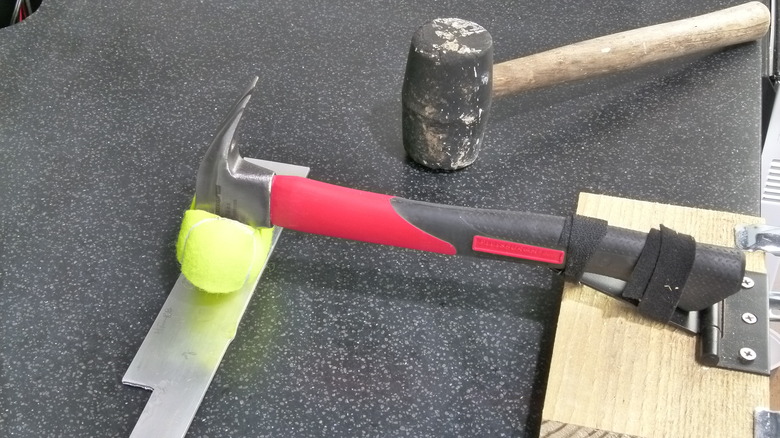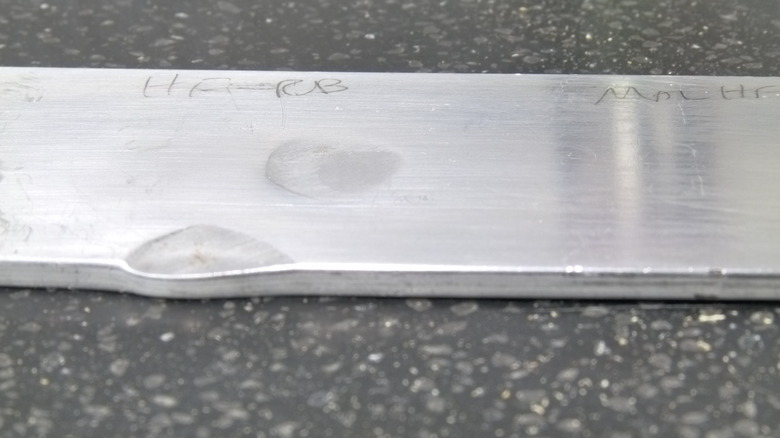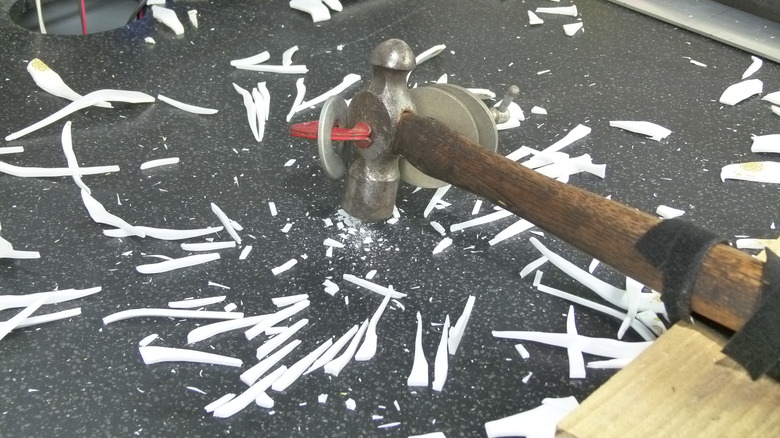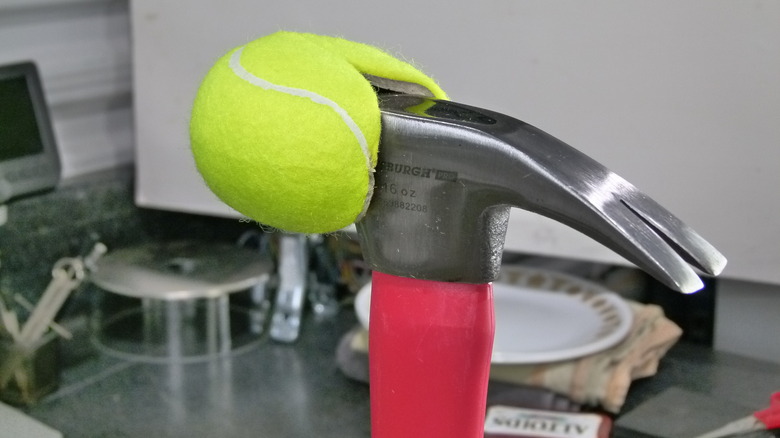We Tried Transforming A Hammer Into A Mallet Using A Tennis Ball With Smashing Success
We may receive a commission on purchases made from links.
The thing looks ridiculous: a hammer with a tennis ball stuck on its business end, like an ill-fitting clown nose or the aftermath of a misguided attempt to play tennis on the job site. Nevertheless, we ran across this "hack," by which you convert a hammer into a mallet by sticking a tennis ball on it, just about everywhere — in publications (such as the Orlando Sentinel) and on YouTube and social media. As always, we had to test something this simple and promising. In concept, the contraption looks like an irrefutable win; why on earth wouldn't it work? Tons of obviously workable solutions fail for the tiniest unforeseen reasons, but this one didn't.
You could argue that average homeowners need a mallet more than a hammer. And ideally, everyone would have both since there's not a lot of overlap when they're used properly. For example, we all occasionally need to hammer in a nail to hang a picture. Similarly, we all occasionally need (or want) to bang on something without breaking it — the rubber mallet's domain. But unfortunately, you can't convert a mallet into a hammer. (Not yet, anyway. Does anyone have a croquet ball handy?)
The idea of most mallets is to do less damage than a basic hammer would. We wanted to find out if this Frankenhammer could fulfill this requirement — or if we would be left unable to assemble furniture or play tennis.
Figuring out how to damage things with a hammer
We set out to see if our $8.99 Harbor Freight hammer, malletized with a $.63 tennis ball from Walmart, would perform as well as an actual rubber mallet. But how could we test this? As much as we wanted to construct a mallet version of this MIT researcher's golf-ball cannon, a scientifically rigorous test didn't seem as important as real-world experience with our improvised mallet. And it's a good thing, too, because scientifically rigorous measurement of hammers hitting things turns out to be very complicated. So after a few unproductive hours pondering load sensors, weight distribution, stress-strain diagrams, and elastic limits, we settled on the simple (if disreputable) approach of breaking things with hammers.
So we devised a way to compare our hammer, our makeshift mallet, an actual rubber mallet, and a few other whackin' tools thrown in for good measure. A hinged mechanism would allow hammers and mallets to fall under their own weight onto various flat objects — aluminum bar stock, a soft board, inverted salad plates, and thin aluminum flashing glued onto a half-inch expanded polystyrene insulation board. (This last one was added so we had a material we were almost certain to damage with most of our implements.) We also attached large washers and a small concrete cone when appropriate to ensure all the test subjects had comparable weights.
What happens with you beat on things with a homemade mallet
We then set about dropping the hammer, so to speak, on each of our test materials and looking for damage. Just because it's fun to hit stuff with hammers, in addition to using our test rig, we also whacked the aluminum and wood as hard as we could with each mallet and hammer.
Although aluminum is a very soft metal, it held up pretty well to the first round of tests, during which we allowed the hammer to fall under its own weight. The un-malletized hammer caused minor marring, and the rubber mallet might have as well (it was too close to call). None of the other tools made a mark. The pine board showed minor dings from the hammers and the black rubber side of a multi-head mallet we tried. The thin flashing was damaged by everything that struck it, especially the hammer. The salad plate held up until a ball peen hammer shattered it in the last test of the round.
Notwithstanding that shattered plate, the second round (in which we hit things as hard as possible with the natural and un-malletized hammer) was more dramatic. A misaimed hammer blow to the aluminum stock hit the edge, which it deformed and compressed. A second hammer blow made a noticeable and fairly deep mark, while the ball-covered hammer made no impression. We got precisely the same result with the pine board.
Why you should really try this tennis ball hack yourself
Mallets are used to limit damage from compression (like marring, dents, breakage, or a swollen finger and much cursing) by distributing a blow over a large area, cushioning the impact, or bouncing (which is the least useful due to wasted energy). Our makeshift mallet did this very well. It caused no visible damage to any surface other than the flashing, which could have been visibly damaged by a stern look or inelegant phrase. But the rubber mallet did dent everything very slightly except the aluminum bar stock, and it left black marks in a few places.
When we really slammed the hammer into the aluminum and wood, the hammer itself made quite a dent, while the tennis ball continued to do no harm. So, based on this limited (and profoundly unscientific) evidence, you might be better off with a tennis ball in your toolbox than a rubber mallet since it appears to cause less physical and cosmetic damage.
One bit of advice: Cut the tennis ball so that the head of the hammer can reach all the way into it and contact the opposite side. That is, you should be able to feel the hammer touching the inside of the ball so that when it strikes something, it won't waste a lot of energy moving the ball against the hammer's face. When we tried the hack without doing that, the thing bounced a lot and didn't accomplish much.



